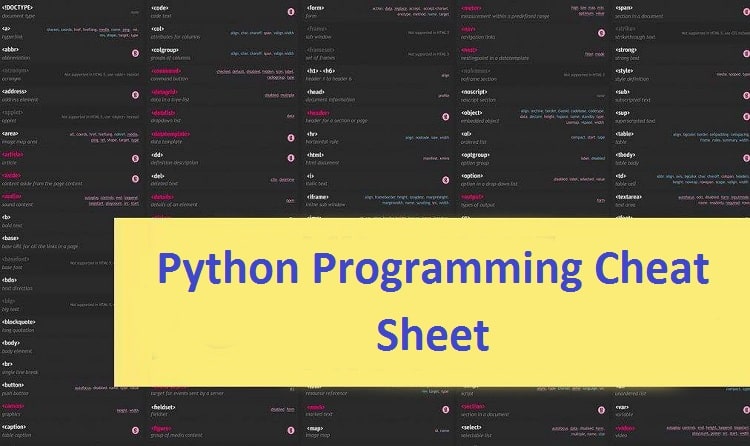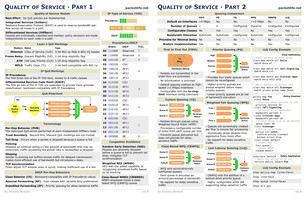Advance Python Cheat sheet from beginners to advance 2020. With the help This cheat sheet You will be able to Understand Python basic with reference.You can download Free these Python cheats
Python Cheat Sheet for Lists
Python Cheat Sheet for dictionaries
Python Cheat Sheet for if statements and while loops
Python Cheat Sheet for functions
Python Cheat Sheet for classes
Python Cheat Sheet for Files & Exceptions
Python Cheat Sheet for Testing Code
Python Cheat Sheet for Pygame
Python Cheat Sheet for Matplotlib
Python Cheat Sheet for Pygal
Python Cheat Sheet for Django
- Python Django Cheat Sheet
- Python Django Projects
- Python Django Cheat Sheet Answer
- Python Django Cheat Sheet Answers
Python Django Cheat Sheet
Jun 18, 2020 - Explore Simple Cheat Sheet's board 'Django Cheat Sheet' on Pinterest. See more ideas about Cheat sheets, Web application, Writing. The Ultimate Cheat Sheet of Equivalents in Python and JavaScript. This cheat sheet highlights analogies in Python and JavaScript. It might be interesting to you if you are a full-stack developer working with Django, Flask, Pyramid, or another Python-based framework, a server-side developer who wants to better understand the frontend, or a front. From django.contrib import admin from.models import Topic admin.site.register(Topic) Beginner's Python Cheat Sheet – Django Creating a project To start a project we’ll create a new project, create a database, and start a development server. $ django-admin startproject learninglog. Create a database $ python manage.py migrate View the project.
Note: Advance Programming Tutorial Available on our YouTube Channel : Techprofree . Search on YouTube . Subscribe Our Channel.
Basic Concepts
| Integers | 1,2,3,4,5,6,76, |
| Floating-point numbers | 2.4 , 2.3, 4.5, 4.5 , |
| String | ‘abc’ , ‘ads’ , ‘aaa’ |
Basic Math Operator used in Python
| + | Addition |
| – | Subtraction |
| * | Multiplication |
| / | Division |
| // | Integer division |
| ** | Exponent |
Examples of Operators
Addition
2+3=5
Subtraction
3-2=1
Multiplication Mac word processor download.
2*2=4
Division
The elder scrolls v skyrim free download mac. 4/2=2
Integer Division
22//8 =2
Exponent
2**3=8
Comparison Operations
| >= | Greater than or Equal to |
| <= | Less than or Equal to |
| > | Greater Than |
| < | Less than |
| != | Not equal to |
| Equal to |
Download Full Python Cheat-sheet
Virus note:
- All files are scanned by Team of Techringe.com for viruses
- Kindly Never run .exe’s, .ocx’s, .dll’s etc
- Only Run PDF, Word
The topic guide on Django’s database-abstraction APIdescribed the way that you can use Django queries that create,retrieve, update and delete individual objects. However, sometimes you willneed to retrieve values that are derived by summarizing or aggregating acollection of objects. This topic guide describes the ways that aggregate valuescan be generated and returned using Django queries.

Throughout this guide, we’ll refer to the following models. These models areused to track the inventory for a series of online bookstores:
Cheat sheet¶
In a hurry? Here’s how to do common aggregate queries, assuming the modelsabove:
Generating aggregates over a QuerySet¶
Django provides two ways to generate aggregates. The first way is to generatesummary values over an entire QuerySet. For example, say you wanted tocalculate the average price of all books available for sale. Django’s querysyntax provides a means for describing the set of all books:
What we need is a way to calculate summary values over the objects thatbelong to this QuerySet. This is done by appending an aggregate()clause onto the QuerySet:
The all() is redundant in this example, so this could be simplified to:
The argument to the aggregate() clause describes the aggregate value thatwe want to compute - in this case, the average of the price field on theBook model. A list of the aggregate functions that are available can befound in the QuerySet reference.
aggregate() is a terminal clause for a QuerySet that, when invoked,returns a dictionary of name-value pairs. The name is an identifier for theaggregate value; the value is the computed aggregate. The name isautomatically generated from the name of the field and the aggregate function.If you want to manually specify a name for the aggregate value, you can do soby providing that name when you specify the aggregate clause:
If you want to generate more than one aggregate, you add another argument tothe aggregate() Apple prores 4444 xq codec download mac. clause. So, if we also wanted to know the maximum andminimum price of all books, we would issue the query:
Generating aggregates for each item in a QuerySet¶
The second way to generate summary values is to generate an independentsummary for each object in a QuerySet. For example, if you areretrieving a list of books, you may want to know how many authors contributedto each book. Each Book has a many-to-many relationship with the Author; wewant to summarize this relationship for each book in the QuerySet.
Per-object summaries can be generated using theannotate() clause. When an annotate() clause isspecified, each object in the QuerySet will be annotated with thespecified values.
The syntax for these annotations is identical to that used for theaggregate() clause. Each argument to annotate() describesan aggregate that is to be calculated. For example, to annotate books with thenumber of authors:
As with aggregate(), the name for the annotation is automatically derivedfrom the name of the aggregate function and the name of the field beingaggregated. You can override this default name by providing an alias when youspecify the annotation:
Unlike aggregate(), annotate() is not a terminal clause. The outputof the annotate() clause is a QuerySet; this QuerySet can bemodified using any other QuerySet operation, including filter(),order_by(), or even additional calls to annotate().
Combining multiple aggregations¶
Combining multiple aggregations with annotate() will yield thewrong results because joins are used instead of subqueries:
For most aggregates, there is no way to avoid this problem, however, theCount aggregate has a distinct parameter thatmay help:
If in doubt, inspect the SQL query!
In order to understand what happens in your query, consider inspecting thequery property of your QuerySet.
Joins and aggregates¶
So far, we have dealt with aggregates over fields that belong to themodel being queried. However, sometimes the value you want to aggregatewill belong to a model that is related to the model you are querying.
When specifying the field to be aggregated in an aggregate function, Djangowill allow you to use the same double underscore notation that is used when referring to related fields infilters. Django will then handle any table joins that are required to retrieveand aggregate the related value.
For example, to find the price range of books offered in each store,you could use the annotation:
This tells Django to retrieve the Store model, join (through themany-to-many relationship) with the Book model, and aggregate on theprice field of the book model to produce a minimum and maximum value.

The same rules apply to the aggregate() clause. If you wanted toknow the lowest and highest price of any book that is available for salein any of the stores, you could use the aggregate:
Join chains can be as deep as you require. For example, to extract theage of the youngest author of any book available for sale, you couldissue the query:
Following relationships backwards¶
In a way similar to Lookups that span relationships, aggregations andannotations on fields of models or models that are related to the one you arequerying can include traversing “reverse” relationships. The lowercase nameof related models and double-underscores are used here too.
For example, we can ask for all publishers, annotated with their respectivetotal book stock counters (note how we use 'book' to specify thePublisher -> Book reverse foreign key hop):
(Every Publisher in the resulting QuerySet will have an extra attributecalled book__count.)
We can also ask for the oldest book of any of those managed by every publisher:
(The resulting dictionary will have a key called 'oldest_pubdate'. If nosuch alias were specified, it would be the rather long 'book__pubdate__min'.)
This doesn’t apply just to foreign keys. It also works with many-to-manyrelations. For example, we can ask for every author, annotated with the totalnumber of pages considering all the books the author has (co-)authored (note how weuse 'book' to specify the Author -> Book reverse many-to-many hop):
(Every Author in the resulting QuerySet will have an extra attributecalled total_pages. If no such alias were specified, it would be the ratherlong book__pages__sum.)
Or ask for the average rating of all the books written by author(s) we have onfile:
(The resulting dictionary will have a key called 'average_rating'. If nosuch alias were specified, it would be the rather long 'book__rating__avg'.)
Aggregations and other QuerySet clauses¶
filter() and exclude()¶
Aggregates can also participate in filters. Any filter() (orexclude()) applied to normal model fields will have the effect ofconstraining the objects that are considered for aggregation.
When used with an annotate() clause, a filter has the effect ofconstraining the objects for which an annotation is calculated. For example,you can generate an annotated list of all books that have a title startingwith “Django” using the query:
When used with an aggregate() clause, a filter has the effect ofconstraining the objects over which the aggregate is calculated.For example, you can generate the average price of all books with atitle that starts with “Django” using the query:
Filtering on annotations¶
Annotated values can also be filtered. The alias for the annotation can beused in filter() and exclude() clauses in the same way as any othermodel field.
For example, to generate a list of books that have more than one author,you can issue the query:
This query generates an annotated result set, and then generates a filterbased upon that annotation.
If you need two annotations with two separate filters you can use thefilter argument with any aggregate. For example, to generate a list ofauthors with a count of highly rated books:
Each Author in the result set will have the num_books andhighly_rated_books attributes. See also Conditional aggregation.
Choosing between filter and QuerySet.filter()

Avoid using the filter argument with a single annotation oraggregation. It’s more efficient to use QuerySet.filter() to excluderows. The aggregation filter argument is only useful when using two ormore aggregations over the same relations with different conditionals.
Order of annotate() and filter() clauses¶
When developing a complex query that involves both annotate() andfilter() clauses, pay particular attention to the order in which theclauses are applied to the QuerySet.
When an annotate() clause is applied to a query, the annotation is computedover the state of the query up to the point where the annotation is requested.The practical implication of this is that filter() and annotate() arenot commutative operations.
Given:
- Publisher A has two books with ratings 4 and 5.
- Publisher B has two books with ratings 1 and 4.
- Publisher C has one book with rating 1.
Here’s an example with the Count aggregate:
Python Django Projects
Both queries return a list of publishers that have at least one book with arating exceeding 3.0, hence publisher C is excluded.
In the first query, the annotation precedes the filter, so the filter has noeffect on the annotation. distinct=True is required to avoid a querybug.
The second query counts the number of books that have a rating exceeding 3.0for each publisher. The filter precedes the annotation, so the filterconstrains the objects considered when calculating the annotation.
Here’s another example with the Avg aggregate:
The first query asks for the average rating of all a publisher’s books forpublisher’s that have at least one book with a rating exceeding 3.0. The secondquery asks for the average of a publisher’s book’s ratings for only thoseratings exceeding 3.0.
It’s difficult to intuit how the ORM will translate complex querysets into SQLqueries so when in doubt, inspect the SQL with str(queryset.query) andwrite plenty of tests.
order_by()¶
Annotations can be used as a basis for ordering. When youdefine an order_by() clause, the aggregates you provide can referenceany alias defined as part of an annotate() clause in the query.
For example, to order a QuerySet of books by the number of authorsthat have contributed to the book, you could use the following query:
values()¶
Ordinarily, annotations are generated on a per-object basis - an annotatedQuerySet will return one result for each object in the originalQuerySet. However, when a values() clause is used to constrain thecolumns that are returned in the result set, the method for evaluatingannotations is slightly different. Instead of returning an annotated resultfor each result in the original QuerySet, the original results aregrouped according to the unique combinations of the fields specified in thevalues() clause. An annotation is then provided for each unique group;the annotation is computed over all members of the group.
For example, consider an author query that attempts to find out the averagerating of books written by each author:
This will return one result for each author in the database, annotated withtheir average book rating.
However, the result will be slightly different if you use a values() clause:
In this example, the authors will be grouped by name, so you will only getan annotated result for each unique author name. This means if you havetwo authors with the same name, their results will be merged into a singleresult in the output of the query; the average will be computed as theaverage over the books written by both authors.
Order of annotate() and values() clauses¶
As with the filter() clause, the order in which annotate() andvalues() clauses are applied to a query is significant. If thevalues() clause precedes the annotate(), the annotation will becomputed using the grouping described by the values() clause.
Python Django Cheat Sheet Answer
However, if the annotate() clause precedes the values() clause,the annotations will be generated over the entire query set. In this case,the values() clause only constrains the fields that are generated onoutput.
For example, if we reverse the order of the values() and annotate()clause from our previous example:
This will now yield one unique result for each author; however, onlythe author’s name and the average_rating annotation will be returnedin the output data.
You should also note that average_rating has been explicitly includedin the list of values to be returned. This is required because of theordering of the values() and annotate() clause.
If the values() clause precedes the annotate() clause, any annotationswill be automatically added to the result set. However, if the values()clause is applied after the annotate() clause, you need to explicitlyinclude the aggregate column.
Interaction with default ordering or order_by()¶
Fields that are mentioned in the order_by() part of a queryset (or whichare used in the default ordering on a model) are used when selecting theoutput data, even if they are not otherwise specified in the values()call. These extra fields are used to group “like” results together and theycan make otherwise identical result rows appear to be separate. This shows up,particularly, when counting things.
Python Django Cheat Sheet Answers
By way of example, suppose you have a model like this:
The important part here is the default ordering on the name field. If youwant to count how many times each distinct data value appears, you mighttry this:
…which will group the Item objects by their common data values andthen count the number of id values in each group. Except that it won’tquite work. The default ordering by name will also play a part in thegrouping, so this query will group by distinct (data,name) pairs, whichisn’t what you want. Instead, you should construct this queryset:
…clearing any ordering in the query. You could also order by, say, datawithout any harmful effects, since that is already playing a role in thequery.
This behavior is the same as that noted in the queryset documentation fordistinct() and the general rule is thesame: normally you won’t want extra columns playing a part in the result, soclear out the ordering, or at least make sure it’s restricted only to thosefields you also select in a values() call.
Note
You might reasonably ask why Django doesn’t remove the extraneous columnsfor you. The main reason is consistency with distinct() and otherplaces: Django never removes ordering constraints that you havespecified (and we can’t change those other methods’ behavior, as thatwould violate our API stability policy).
Aggregating annotations¶
You can also generate an aggregate on the result of an annotation. When youdefine an aggregate() clause, the aggregates you provide can referenceany alias defined as part of an annotate() clause in the query.
For example, if you wanted to calculate the average number of authors perbook you first annotate the set of books with the author count, thenaggregate that author count, referencing the annotation field:




